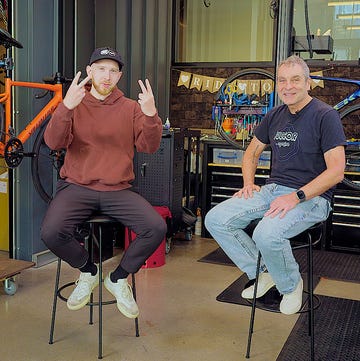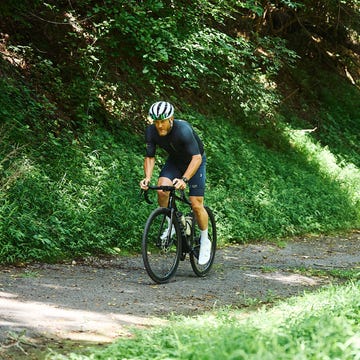Sidi is one of those legacy brands whose name evokes misty eyes from a certain population of cyclists. These riders will wax poetic about the Italian craftsmanship, fit, comfort, and durability of the Italian brand's shoes. And Sidi certainly deserves a lot of respect.
They were one of the first to produce clipless-compatible shoes during the transition away from toe clips toward ski-binding-style step-in pedals. They were the first brand to put a mechanical closure on a cycling shoe, and they were a leader in the adoption of materials like non-stretch synthetic leather and mesh. They also offered replacement parts for their shoes, extending their usable life, and offered multiple widths and a great size range.
But like a lot of legacy brands, they wobbled at a crucial time. Specifically, when high-performance cycling shoes began to adopt carbon soles with simultaneous attention paid to shoe weights.
While brands newer to the shoe game—especially Shimano and Specialized—went all in on thin and stiff carbon soles and diligently worked to decrease the weight of shoes, Sidi stubbornly stuck with nylon soles. As a result, Sidi's shoes were heavy and felt less efficient than the upstart shoes. This was compounded by Sidi's ultra-premium pricing: A lot of riders began to wonder why they should spend more for a shoe that was heavier and less stiff than the competition.
When I asked Sidi representatives why it stuck with nylon soles when customer demand for carbon-soled shoes was clearly swelling, they stated that it was their belief that the added flex of a softer sole made the shoe more comfortable and reduced hot spots, which was more important than stiffness.
When they did, begrudgingly, start to add carbon to their soles, they used clunky bolt-on plates inserted into the nylon sole that didn't add much stiffness but did add more bulk.
Like a lot of riders at the time, I found myself moving on from Sidi even though I once viewed them as the pinnacle of cycling footwear. The new carbon-soled shoes were lighter, stiffer, plenty comfortable, and cheaper.
It was hard to watch a brand that achieved its stellar reputation because it was so innovative fade from prominence because it wasn't keeping pace with riders' demands. Sidi didn't go away, but they became a rare sight. And for over a decade, no Sidi alighted my foot.
An Italian brand that was once the darling of cyclists' hearts but lost favor in recent years by not keeping up with product trends—where have I heard that before?
But a few months ago, I got a message from a Sidi representative. They were working on reestablishing their presence in the USA and had new products—would I like to try their latest?
Curious, but apprehensive, I said yes. And soon the new Ergo 6 arrived at my doorstep. And all at once, I'm ready to get misty-eyed about Sidi again.
It's a beautiful shoe, and still made in Italy. Better, it has a thin carbon sole—and a full-length one. It's as stiff as any other high-performance shoe I've recently used, and Sidi added one of my favorite shoe features: Cleat mounts with 15mm of fore/aft adjustment.
Sidi's still not close to winning the weight game, but it's competitively lightweight enough (about 270 grams per shoe) to not be an issue unless you're a single-issue shoe shopper.
The upper is seamless and supple: They feel luxurious as you slip a foot in. The Ergo 6's employ Sidi's "Millennium" fit, which is comfortably roomier than the slipper-like (AKA narrow!) fit Sidi shoes are known for. I'd describe Millennium as similar to, and slightly wider than, the fit of the regular-width Specialized S-Works Torch.
Sidi still offers models with the "Classic" fit if you like your cycling shoes to fit like rock climbing shoes, but I think the Millennium fit will suit more riders.
There is a double closure with Sidi's own dials and not an off-the-rack Boa. They are charming in their own funky way. Press the button in the middle of the dial and a flap pops up so you can tighten the shoe; snap the flap down again to make the dials low profile. Buttons on the side of the dial let you spool out cable in small increments to fine-tune fit: squeeze them together to release the cable and remove the shoe.
Certainly, a two-way Boa S3 dial is simpler, but I want this weird closure on my Sidi. I want Sidi to make a competitively light and stiff shoe, but I want them to do it their way.
At $400, the Ergo 6 carries a stiff price tag. But $400 is cheaper—yes, cheaper—than the Specialized S-Works Torch ($450), Shimano RC-903 ($450), Lake CX333 ($500), Trek RSL ($450), and others.
I've got a few hundred miles of mixed indoor and outdoor riding in my new Ergo 6s, and they're quickly becoming my favorite shoes. And not because of nostalgia or because I'm rooting for the underdog. It's because the Ergo 6 is a great shoe that's attractive, light, stiff, comfortable, and competitively priced.
Welcome back to my feet, Sidi. Hope you're here for a while.

A gear editor for his entire career, Matt’s journey to becoming a leading cycling tech journalist started in 1995, and he’s been at it ever since; likely riding more cycling equipment than anyone on the planet along the way. Previous to his time with Bicycling, Matt worked in bike shops as a service manager, mechanic, and sales person. Based in Durango, Colorado, he enjoys riding and testing any and all kinds of bikes, so you’re just as likely to see him on a road bike dressed in Lycra at a Tuesday night worlds ride as you are to find him dressed in a full face helmet and pads riding a bike park on an enduro bike. He doesn’t race often, but he’s game for anything; having entered road races, criteriums, trials competitions, dual slalom, downhill races, enduros, stage races, short track, time trials, and gran fondos. Next up on his to-do list: a multi day bikepacking trip, and an e-bike race.














